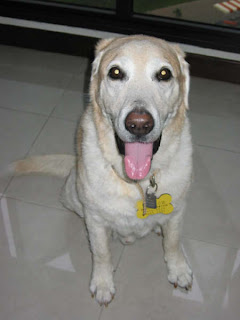

Breed Group: Working
Weight: male: 45-60, female: 35-50 lbs
Height: male: 21-23.5, female: 20-22 inches
Color(s): All colors from black to pure white
Coat: The Siberian Husky has a medium length double coat. The under coat is dense and soft in texture. The outer coat is longer and coarse with straight guard hairs. Their coat comes in a variety of colors and patterns. The most common colors are black and white, gray and white, copper red and white, and pure white. The facial markings include masks and spectacles. The Siberian Husky is a constant shedder that totally sheds the undercoat twice a year.
Overview: The Siberian Husky originated in northeastern Siberia as an endurance sled dog. In 1909 large numbers of this breed arrived in Alaska to participate in sled racing. The Siberian Husky's endurance, stamina, and strength quickly made them a popular breed in the Arctic region.
Character: The Siberian Husky is a compact and strong working dog. They are able to withstand temperatures as low as 75 degrees below zero, so are best suited for cooler to cold climates. They display a measure of dignity and reserve. The Siberian Husky is an amiable companion and willing worker.
Temperament: The Siberian Husky has an affectionate, gentle, and friendly disposition. They are alert and eager to please. They are highly intelligent and have an independent spirit, which can sometimes be a challenge to their owner. This versatile breed gets along very well with children and other medium sized dogs. However, their strong predatory instinct makes them dangerous to cats and other small pets. The Siberian Husky thrives in a family environment but does not become overly attached to one specific person. They will exhibit no fear or suspicion of strangers. They are not well suited for a two career family and require attention and companionship. They prefer to live in packs.
Care: The Siberian Husky is by nature clean and free from body odor. They require daily brushing to minimize excess loose hair, tangles, and mats. Bathing should only be done when absolutely necessary with a mild shampoo. The Siberian Husky is prone to hip dysplasia, cataracts, and skin allergies. It is extremely vital that they do not become overheated.
Training: The Siberian Husky is highly intelligent but has a mind of its own. They will only obey a command if they see the point of it. They respond best to patience, consistency, and fairness. They will quickly take advantage of an owner that doesn't let them know who the boss is. They may be difficult to housebreak. The crate training method is recommended. They will do well with early obedience training.
Activity: The Siberian Husky has an innate and deep desire to run. They do best with a large securely fenced yard. If they are left alone for extended periods of time they will become bored which leads to digging and destruction. They make excellent walking and jogging companions provided they are very securely leashed and the climate is not too hot. The Husky is not recommended for apartment dwelling unless they are exceedingly well trained and sufficiently exercised.


















